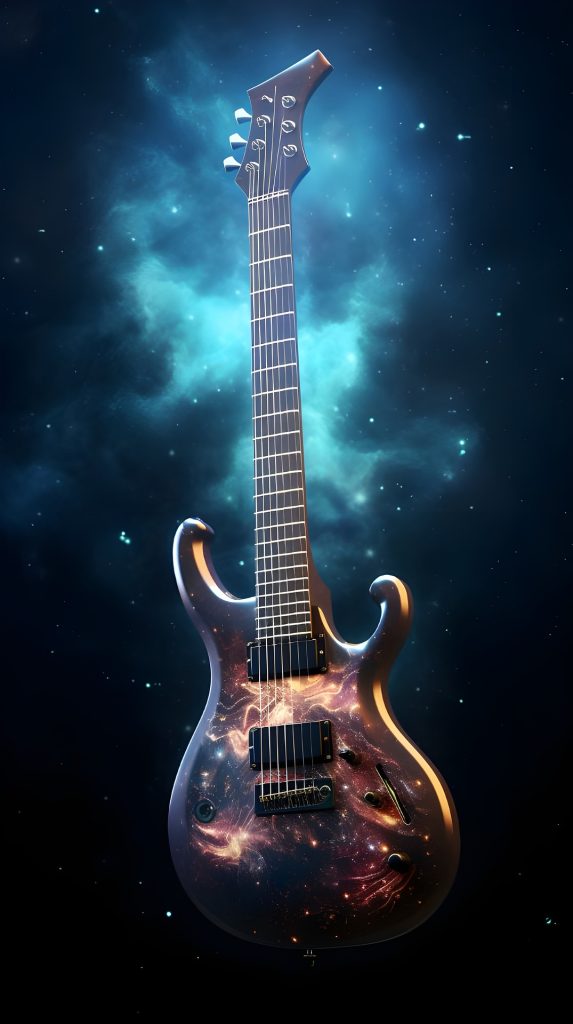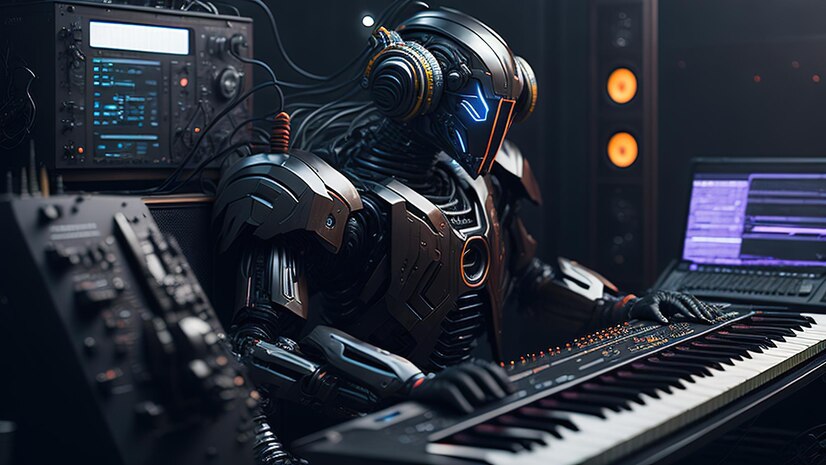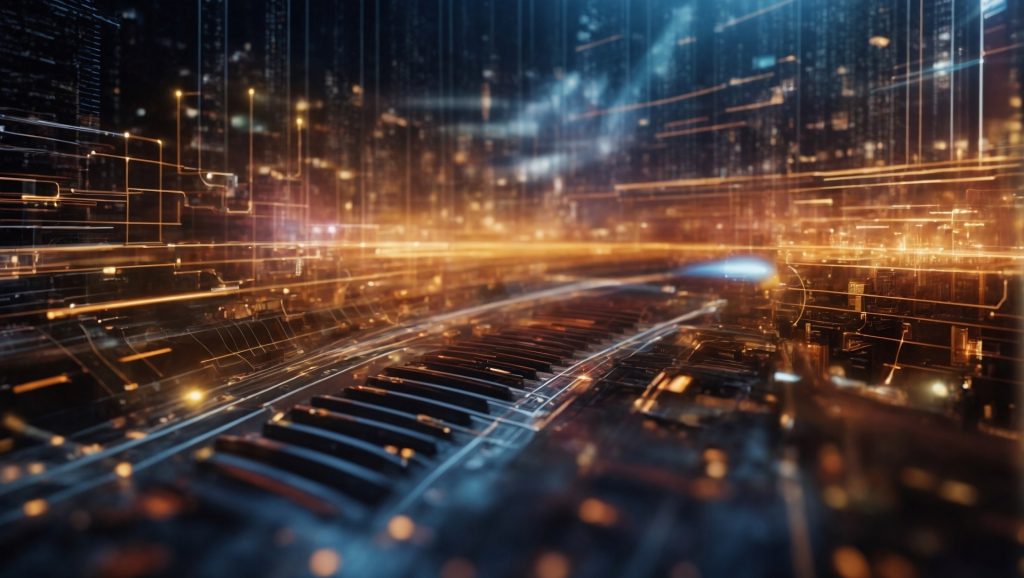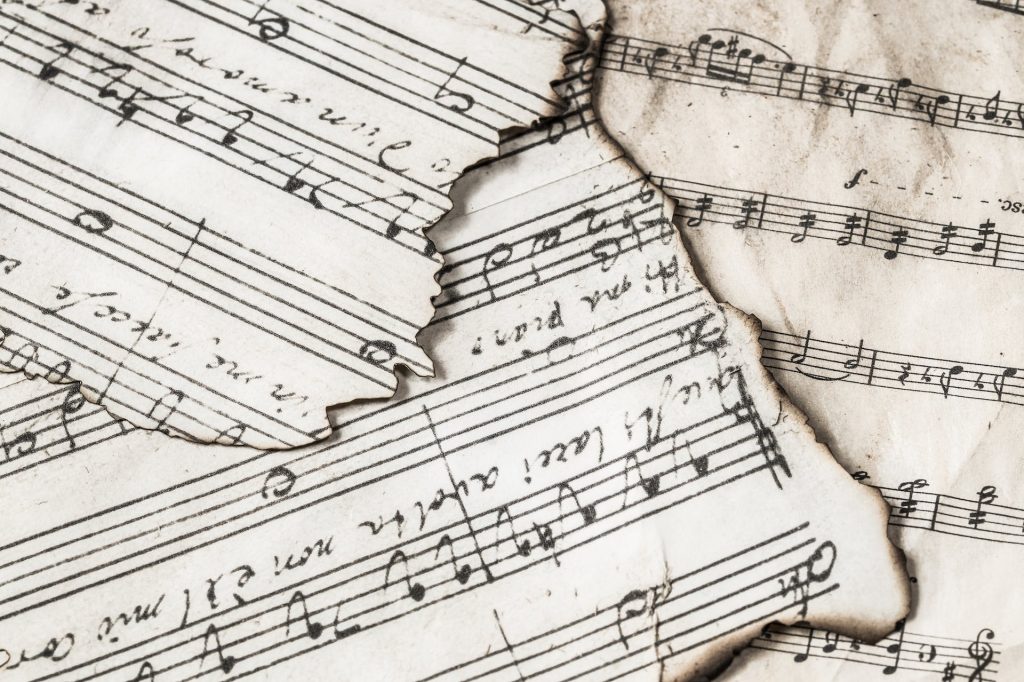The advent of artificial intelligence (AI) has ushered in a paradigm shift across industries, and the music business is no exception. As AI technologies become further integrated into the creative process, the field stands poised on the brink of transformation. On one hand, AI-enabled tools promise to act as a democratizing force – granting more individuals access to music creation irrespective of formal training. However, fears abound regarding the potential homogenization of musical expression and the propagation of soulless, AI-generated compositions.
Navigating the debate surrounding emerging technologies, the music industry must strike a delicate balance between utilizing AI to push creative boundaries while retaining the essence of human artistry. The following analysis will examine both the optimistic and cautious perspectives on AI in music, addressing its application in tasks spanning composition, production, marketing, and distribution.
Democratization of Music Creation
One of the most transformative capacities of AI lies in its potential to tear down barriers to musical creation. Composing compelling melodies and harmonies has traditionally remained within the exclusive purview of those with advanced music theory knowledge or instrumental prowess. AI-powered tools effectively nullify these prerequisites.
Enabled by neural networks and deep learning, AI systems can now analyze vast databases of existing songs, internalize the patterns and structures that define different musical styles, and subsequently generate original compositions adhering to the learned models. Companies such as Amper, Aiva, and Balbek Bureau have developed algorithms that allow users with minimal music skills to instantly produce AI-assisted tracks spanning diverse genres.
By handling the heavy lifting of harmonic and melodic arrangement, such generative AI permits those with rudimentary music knowledge to realize their creative visions. This paves the way for both professional refinement via technological augmentation and amateur self-expression through intuitive music-making apps. Consequently, AI promotes inclusion and grants more aspirants entry into the industry’s creative circles.

Streamlining Production Processes
Beyond democratizing active songwriting, AI also plays a key role in optimizing efficiency during music production. For professional composers and producers alike, crafting a track often demands investing tedious hours in repetitive tasks such as editing multiple takes to compile the perfect vocal recording or drawing in MIDI information to communicate desired instrumental parts.
AI has the capacity to automate many of these mundane processes; software solutions like Hit’n’Mix utilize machine learning algorithms to seamlessly edit together vocal takes, allowing producers to bypass the intensive process of manual editing. Similarly, applications such as Notation Performer and Aiva handle the automatic transcription of audio into sheet music and MIDI data, bypassing labor-intensive notation. Such time-saving functionalities have the potential to grant artists and producers higher bandwidth to focus on the creative aspects.
From drum pattern generation to chord substitution suggestion, AI is poised to rescue musicians from many of production’s most tedious duties. Its integration stands not only to bolster productivity but also spur newfound creativity by relieving artists of conventional constraints.
Fostering Innovative Musical Directions
In addition to expediting existing processes, AI flaunts untapped potential to pioneer novel musical styles, capitalizing on its impartiality to human creative biases. Drawing input from infinitely more musical references than any individual artist, AI systems assimilate the full gamut of historically established forms while remaining unconstrained by the innate preferences that color human creativity.
This unique position permits algorithmic music generation to fuse disparate genres and instrumentation in ways no human composer might envision, birthing unconventional and unprecedented musical hybrids. CloudBounce – an AI application under development at Google – promises exactly such genre-agnostic experimentation; training a neural network on a dataset of over 300,000 songs spanning all styles, the tool allows users to seamlessly interpolate between genres, potentially catalyzing the emergence of entirely new musical species.
Besides enabling cross-pollination between established genres, AI also exhibits prowess in mastering niche styles of music. Spanish startup LifeScore, for instance, employs proprietary AI to compose background scores flawlessly matched to the context and emotional tenor of video content. Built on neural networks drinking from an extensive cinematic soundtrack corpus, LifeScore’s AI greatly outstrips human capacity to consistently score a multitude of diverse video scenes. Such hyper-specialized algorithmic mastery hints at AI’s immense and relatively untapped potential across musical niches.
With access to musical microcosms far beyond human reach, AI may birth sounds unimaginable within existing creative confines. Its genre-fluid flexibility hints at future listening experiences vastly more eclectic and singular than anything achieved by even the most avant-garde artists.

Algorithmic Composition – Boon or Bane?
However, despite its democratizing and innovative promise, AI integration equally courts fears surrounding creative compromise. Central among reservations is the question of authentic emotional expression – can algorithmically generated art, lacking the weight of human experience, truly plumb emotional depths and establish sincere connection?
Much alarmism orbits such doubts that machine-made music must inherently ring hollow and vapid. Yet the notion of computers achieving emotional resonance is perhaps not so far-fetched. Google Brain researcher Curtis Hawthorne makes the case for algorithmic systems eventually rivaling human artistry by arguing the analogous evolution of chess engines – initially doubted as credible opponents yet now decisively surpassing grandmasters. Today’s musical AI remains in embryonic stages akin to early chess programs but will only grow more sophisticated at assimilating emotion’s nuances.
Like all technological sea changes, the proliferation of generative AI warrants healthy skepticism checking unbridled optimism. However, dismissing its creative ceiling risks hindering musical evolution. The most balanced outlook recognizes algorithmic music’s nascency while acknowledging its promise with further development.
Homogenization Hazard
Beyond inauthenticity, industry thought leaders also caution against the homogenizing effect of AI’s generative formats being overwhelmingly adopted. With neural networks reliant on existing music to educate their output, over-propensity toward certain datasets risks breeding AI compositions easily identifiable by their homogenous stylistic tropes.
Such perils of plagiarism and derivativeness echo controversies surrounding human creatives drawing too brazenly from musical forerunners. However, distinct from cases of outright artistic theft, neural networks like those underpinning AI have no concept of plagiarism standards or intellectual property norms. This positions algorithmic music generators to freely incorporate recognized melodic motifs or harmonic sequences as casually as sampling legitimate building blocks rather than creative property.
The resulting compositions then flirt with uninspired pastiche, coagulating into a sludge of overfamiliar elements lacking uniqueness. Mitigating such hazards necessitates AI designers prioritizing model diversity and novelty over recycling established patterns. Networks ought to be rewarded not for recapitulating known melodies but venturing unfamiliar combinations that add to music’s collective color palette rather than just reconstituting its contents.
Only by maximizing exposure to music’s full breadth – beyond commercial juggernauts – can AI source enough diverse raw material to synthesize creations novel enough to push creative boundaries rather than just parroting the past.
Preserving Industry Livelihoods
Lastly, discussions surrounding AI’s scaling adoption must address its disruptive influence on existing industry livelihoods and structures. Automating tasks instrumental to conventional music careers risks destabilizing income streams for working artists and producers. Startups like Phonoloop and Aiva market their automated composition platforms as faster and more economical alternatives to hiring flesh-and-blood creatives, imperiling existing music jobs.
However, framing human and algorithmic creators as strictly adversarial overlooks their symbiotic compatibility. AI need not obliterate human participation but rather unlock new professional pathways symbiotic with machine partnership. Take modern recording engineers who embrace editing automation while concentrating more attention on perfecting aesthetic details algorithmically infeasible. Intuitive musician interfaces alongside AI likewise permit less experienced artists to focus purely on creative direction without technical burdens.
Rather than a wholesale replacement then, AI instead enables human musicians to operate at the apex of their expressive powers while collaborating on computational heavy lifting. Those open to adapting their creative workflows stand to benefit enormously from AI efficiency. By the same token, AI-generated music still necessitates human curation to elevate the most resonant compositions and niche the appliance of generative formats. The ideal future sees human and machine efforts not as mutually exclusive but as complementary forces cooperating fluidly.

Marketing and Distribution Prospects
Beyond reshaping core creative and production pursuits, AI also holds transformative potential across music’s commercial channels – namely marketing and distribution. In an industry increasingly fixated on analytics, AI data parsing offers superior precision in understanding audience engagement and predicting commercial outcomes.
Machine learning analysis of factors such as streaming metrics, online chatter, and listener demographics empowers record labels to target investments with minimizing risk. Startup Pace AI provides such intelligence to its label clients; ingesting over 500,000 data points per song, its predictive algorithms achieve over 92% accuracy in forecasting hits – outperforming even veteran A&R specialists. Such ability to peer into the black box of audience preference grants labels and platforms a key advantage in acquiring only the most viable new signings.
Further down the chain, music distributors leverage similarly sophisticated analytics to direct content to its most receptive listeners amid fierce competition for engagement. Music streaming platforms are increasingly turning to machine learning models in designing their recommendation engines and customizing content to user taste.
Spotify employs various AI bots – including one named Becky – to algorithmically curate playlists optimized for individual listeners based on their activity.

In summary, AI brings both opportunities and challenges as it becomes more integrated into the music industry. Its potential benefits include democratizing music creation, streamlining production, and innovating new musical styles. However, overreliance on AI risks reducing authenticity and diversity. The ideal future likely entails a collaborative synergy between human and machine creativity.
Copyright©dhaka.ai
tags: Artificial Intelligence, Ai, Dhaka Ai, Ai In Bangladesh, Ai In Dhaka, USA



